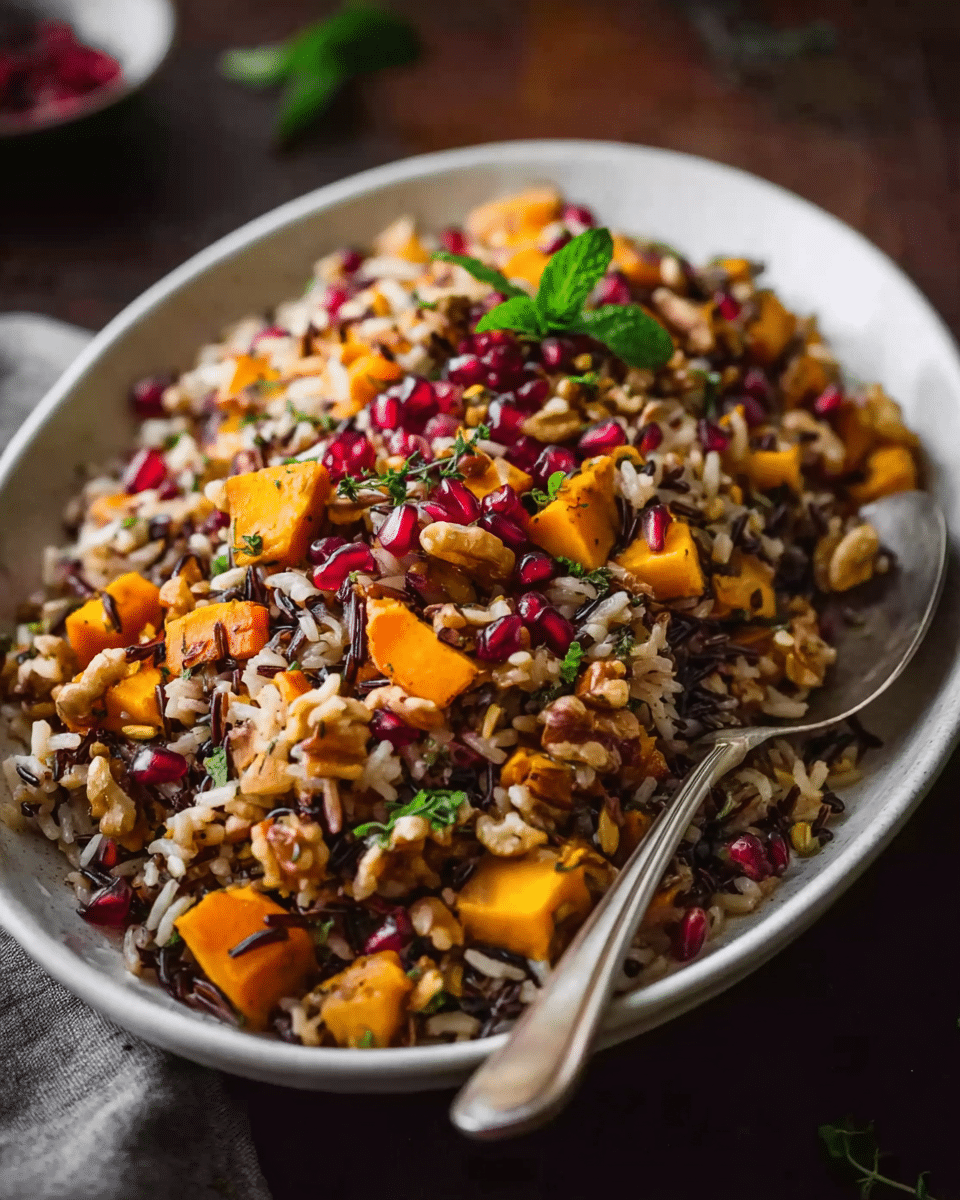This elegant butternut squash wild rice pilaf combines the nutty chew of wild rice, the sweetness of roasted butternut squash, the crunch of walnuts, and the juicy pop of pomegranate seeds. Finished with a honey-lemon vinaigrette and fresh mint, it’s a colorful and flavorful vegetarian main or side dish. Perfect for festive occasions like Thanksgiving or Rosh Hashanah, it celebrates fall’s best ingredients in a dish that can be served warm or at room temperature.
Full Recipe:
Ingredients
-
1 small butternut squash, peeled and cubed
-
1 tsp salt
-
½ tsp pepper
-
2 tbsp oil (for roasting)
-
1½ cups wild rice blend
-
3 cups water
-
1 bay leaf
-
4 tbsp oil (for sautéing)
-
2 purple onions, sliced
-
½ cup walnuts, chopped
-
2 tbsp pomegranate molasses or balsamic vinegar
-
¼ cup olive oil
-
2 tbsp lemon juice
-
4 tsp honey
-
Salt and pepper, to taste
-
4 mint stems, finely diced
-
½ cup pomegranate seeds
Directions
-
Roast Squash: Preheat oven to 450°F (232°C). Place squash cubes on a baking sheet, drizzle with 2 tbsp oil, season with salt and pepper. Roast for 35 min until tender and caramelized.
-
Cook Rice: In a saucepan, combine wild rice blend, water, and bay leaf. Cook per package instructions (about 45–50 min). Drain if needed.
-
Sauté Onions & Walnuts: Heat 4 tbsp oil in a pan. Cook onions for 5 min, add walnuts, cook 2 more min. Add pomegranate molasses or balsamic vinegar, stir, and remove from heat.
-
Make Vinaigrette: In a jar, combine olive oil, lemon juice, honey, salt, and pepper. Shake well to emulsify.
-
Assemble Pilaf: In a large bowl, combine cooked rice, roasted squash, onion-walnut mixture, and diced mint. Toss with vinaigrette.
-
Serve: Transfer to a serving platter, sprinkle with pomegranate seeds, and serve warm or at room temperature.
Nutrients (per serving, approx.)
-
Calories: 522 kcal
-
Carbohydrates: 59 g
-
Protein: 9 g
-
Fat: 30 g
-
Saturated Fat: 3 g
-
Polyunsaturated Fat: 10 g
-
Monounsaturated Fat: 16 g
-
Trans Fat: 1 g
-
Sodium: 404 mg
-
Potassium: 753 mg
-
Fiber: 7 g
-
Sugar: 14 g
-
Vitamin A: 13,328 IU
-
Vitamin C: 33 mg
-
Calcium: 95 mg
-
Iron: 2 mg
The Nutty Foundation of Wild Rice
Wild rice serves as the hearty backbone of this pilaf. Unlike traditional white or brown rice, wild rice has a distinctive chew and earthy, nutty flavor that pairs beautifully with roasted vegetables and bright dressings. Its dark, glossy grains add visual depth to the dish, making the colors of the squash and pomegranate stand out even more. The cooking process allows the grains to split slightly, releasing a subtle aroma that evokes the natural richness of autumn. Beyond taste, wild rice is packed with nutrients, offering higher protein and fiber content than most other rice varieties, making the pilaf both nourishing and satisfying.
The Sweetness of Roasted Butternut Squash
Roasted butternut squash is one of the highlights of this recipe. When cooked at a high temperature, the squash caramelizes on the edges, developing a rich sweetness that contrasts beautifully with the savory components of the dish. Its naturally creamy texture adds softness to the pilaf, balancing the chew of the wild rice and the crunch of the walnuts. The deep orange hue of roasted squash not only enhances the visual appeal but also signals its high beta-carotene content, a powerful antioxidant that supports overall health.
Walnuts for Depth and Crunch
Walnuts bring a toasty richness to the pilaf, contributing both flavor and texture. Lightly sautéed with onions, they develop a warm, nutty aroma that complements the earthy rice and sweet squash. Their crunch provides a satisfying counterpoint to the softer elements in the dish, ensuring each mouthful is dynamic. Additionally, walnuts are a source of heart-healthy omega-3 fatty acids, adding nutritional value alongside their culinary role.
Onions for Sweet-Savory Balance
The use of purple onions adds yet another layer of complexity. Sautéing them until they soften and turn slightly golden coaxes out their natural sweetness, which harmonizes with the roasted squash and honey vinaigrette. When combined with walnuts and finished with pomegranate molasses or balsamic vinegar, the onions take on a sweet-tangy character that ties the different elements of the pilaf together.
The Tang of Pomegranate Molasses
Pomegranate molasses is a key flavor driver in this dish. Its concentrated sweet-tart profile brightens the pilaf, cutting through the richness of the rice and nuts while enhancing the natural sweetness of the squash. If balsamic vinegar is used instead, the result is a slightly mellower acidity with deeper caramel notes, offering a different but equally satisfying balance. In either case, this tangy element is essential for ensuring the pilaf tastes fresh and multidimensional.
The Honey-Lemon Vinaigrette
The vinaigrette is what brings the pilaf to life. The brightness of lemon juice and the subtle sweetness of honey combine to create a dressing that elevates every component of the dish. Olive oil provides a smooth richness, while salt and pepper season the pilaf without overpowering the other flavors. Tossing the ingredients in this vinaigrette ensures the rice grains glisten, the squash is coated with a light sheen, and each bite carries the perfect balance of acidity, sweetness, and savory depth.
Fresh Mint for a Herbal Lift
Fresh mint offers a refreshing contrast to the richer flavors in the pilaf. Its bright, cooling quality cuts through the earthy and nutty notes, adding a burst of freshness to every forkful. Chopped finely, it blends into the dish without dominating, allowing it to act as an accent rather than a main player. Mint also adds to the dish’s visual appeal, its green flecks providing a pop of color that complements the orange squash and red pomegranate seeds.
Pomegranate Seeds for Color and Texture
The final flourish comes from pomegranate seeds, which act as edible jewels scattered across the pilaf. Their juicy pop and vibrant ruby color make them both a visual and textural delight. They contribute bursts of tart-sweet flavor that keep the palate engaged, ensuring the dish never feels heavy. In festive contexts, their color also adds to the celebratory feel, making the pilaf a stunning centerpiece for the holiday table.
Serving Flexibility
One of the strengths of this pilaf is its adaptability. It can be served warm, allowing the roasted squash to release its comforting aroma and the vinaigrette to meld with the rice, or at room temperature, making it a perfect make-ahead dish for potlucks and buffets. As a vegetarian main, it’s hearty enough to satisfy without feeling overly filling. As a side, it pairs wonderfully with roasted poultry, grilled fish, or plant-based mains. Its balance of flavors ensures it complements rather than competes with other dishes.
Nutritional Benefits
This pilaf is as nourishing as it is flavorful. Wild rice provides complex carbohydrates, plant-based protein, and fiber, supporting sustained energy and satiety. Butternut squash offers vitamins A and C, antioxidants, and potassium. Walnuts contribute healthy fats, while pomegranate seeds supply vitamin C and additional antioxidants. Olive oil and honey in the vinaigrette add beneficial fats and natural sweetness without relying on refined sugars. This combination of nutrient-dense ingredients makes the dish not just a festive indulgence but also a wholesome choice for everyday meals.
Visual Appeal and Presentation
Visually, the pilaf is a feast for the eyes. The deep brown tones of wild rice form a rich backdrop for the bright orange of the squash, the deep red of pomegranate seeds, and the green flecks of mint. The glossy sheen from the vinaigrette makes the dish look fresh and inviting. Presented on a large serving platter, it draws the eye and sets the tone for a festive table, encouraging guests to dig in.
Cooking Tips for Best Results
For optimal texture, roast the squash at a high temperature to ensure caramelization without over-softening. When cooking the wild rice, use a bay leaf to infuse it with subtle aromatics. Toast the walnuts lightly before adding them to the onions to bring out their flavor. If making the pilaf ahead of time, reserve some of the vinaigrette to toss through just before serving to refresh the flavors. Finally, sprinkle the pomegranate seeds right before presenting the dish to keep them vibrant and juicy.
Conclusion
Butternut squash wild rice pilaf is a celebration of fall’s bounty, combining earthy grains, sweet roasted vegetables, crunchy nuts, and juicy bursts of pomegranate into one harmonious dish. Its layers of flavor—balanced by the tang of pomegranate molasses and the brightness of a honey-lemon vinaigrette—make it both comforting and refreshing. Whether gracing a holiday table or serving as a wholesome weeknight meal, it offers a versatile, visually stunning, and nutrient-rich option that appeals to a wide range of palates. This is a dish that captures the warmth of the season while showcasing how thoughtful combinations of simple ingredients can create something truly extraordinary.






